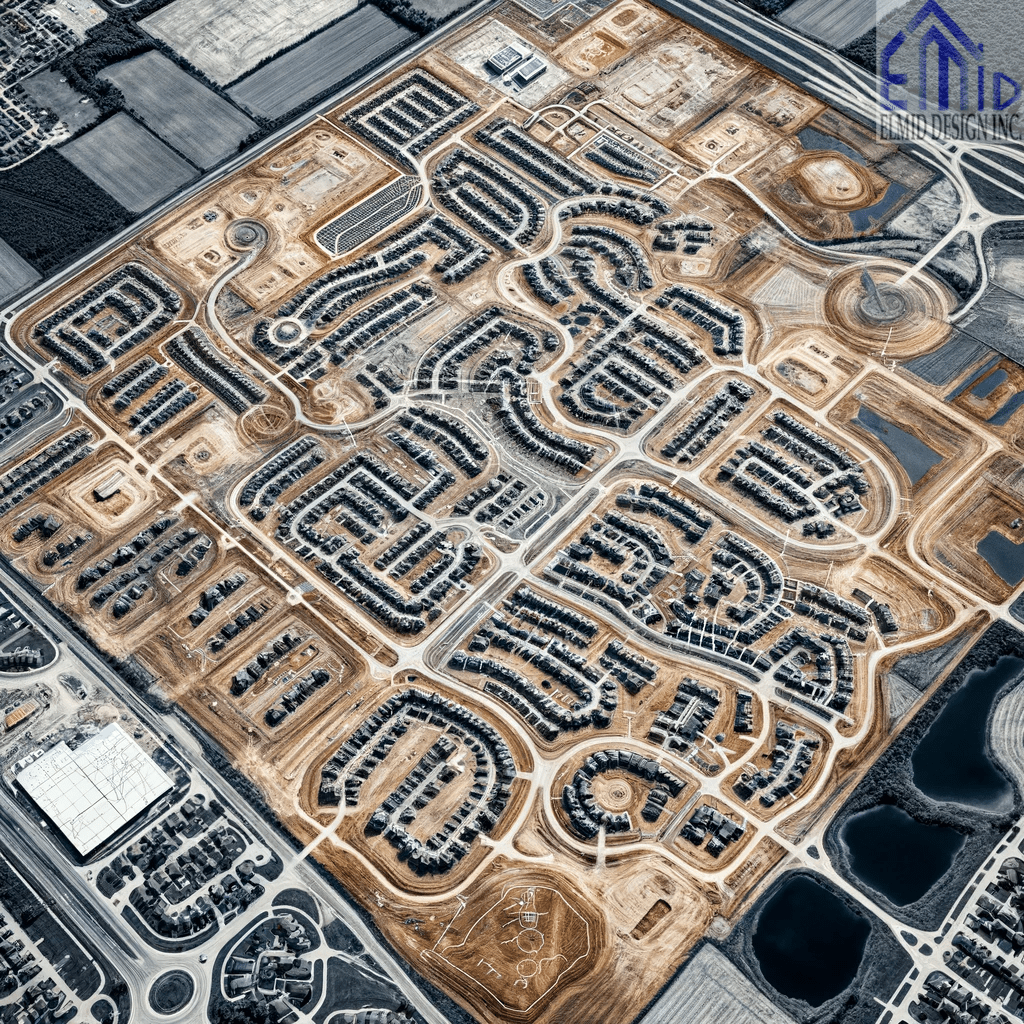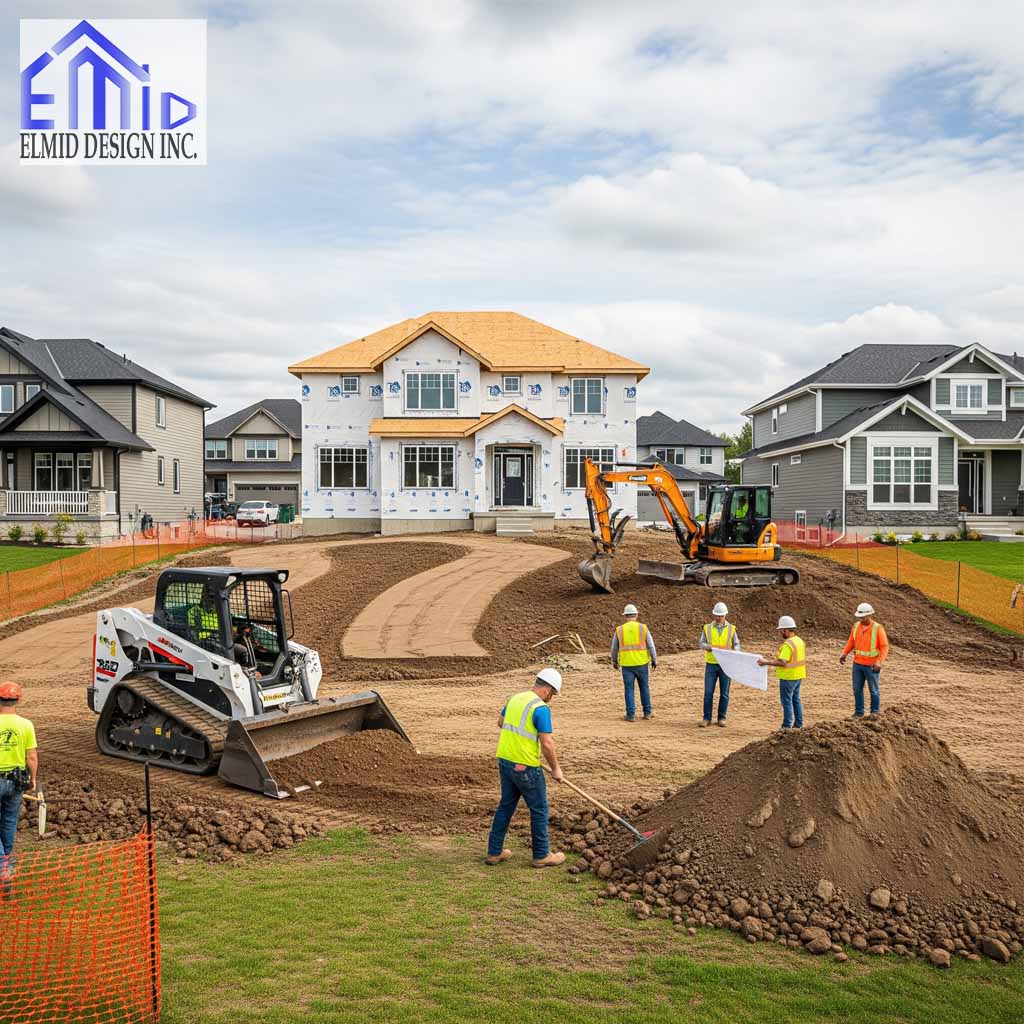A grading plan Grand Valley is a key requirement for new developments, additions, and site alterations within the town. It provides a detailed drawing of how land will be shaped to control water flow, protect structures, and meet municipal standards. Without an approved grading plan, construction permits cannot move forward and projects face costly delays. The Town of Grand Valley requires accurate elevation data, drainage patterns, and erosion control details to ensure both property safety and environmental protection. This article explains what a grading plan is, how Grand Valley regulates submissions, the essential components of each plan, and why compliance is critical. It also highlights how Elmid Design Inc, a PEO-certified engineering firm, helps developers and homeowners secure faster approvals with accurate, permit-ready plans tailored to Grand Valley’s unique requirements.
What Is a Grading Plan in Grand Valley?
A grading plan in Grand Valley is a technical drawing prepared by a licensed professional engineer. It shows existing elevations on a property and proposed adjustments needed for safe drainage. These drawings highlight slopes, swales, and foundation heights to ensure water moves away from structures and into approved outlets. They also include driveway gradients and stormwater features when required. In Grand Valley, grading plans are mandatory for most building permit applications, including new homes, additions, and subdivision developments. They are reviewed alongside site plan submissions, drainage studies, and servicing reports. Without an approved grading plan, the Town will not release permits for construction. This requirement protects both the property under development and the surrounding community by preventing water-related problems that could cause damage or disputes.
Grand Valley’s Regulatory Framework
The Town of Grand Valley enforces grading standards through its planning and development approval processes. Any construction project requiring a building permit may also require a grading plan as part of the submission package. These plans are often paired with site plan applications, functional servicing reports, and stormwater management studies. The municipality also works closely with the Grand River Conservation Authority for projects near environmentally sensitive areas. Developers must demonstrate compliance with provincial building codes as well as local by-laws governing drainage and site alterations. Only professional engineers licensed by Professional Engineers Ontario can prepare or review grading plans. This regulatory framework ensures accountability, technical accuracy, and protection for both municipal infrastructure and private property. By requiring grading plans at the permit stage, Grand Valley prevents costly mistakes and enforces long-term development stability.
Key Components of a Grand Valley Grading Plan
A grading plan Grand Valley submission must include several key details to be approved. Survey data provides existing elevations across the site, while proposed elevations show planned changes after construction. Drainage arrows demonstrate the direction of water flow, and slopes are labeled to confirm compliance with town standards. Swales, retaining walls, and driveway gradients must also appear when applicable. Plans often include erosion and sediment control measures to protect natural features during construction. In subdivision projects, grading plans may be linked with stormwater management facilities and functional servicing reports. A legend, scale, and north arrow ensure clarity for municipal reviewers. These components together provide a complete picture of how the site will function once built. A properly prepared grading plan reduces the likelihood of delays, disputes, or costly corrections during and after construction.
Why Compliance Matters in Grand Valley
Compliance with grading standards in Grand Valley is essential for both property owners and developers. Plans that fail to meet town guidelines are rejected, delaying construction and increasing costs. Even if construction moves forward without proper approval, the consequences are severe. Poor grading can cause flooding, foundation damage, and erosion of landscaped areas. It may also redirect water onto neighboring properties, creating disputes and potential legal liabilities. Compliance ensures safe drainage, protects property value, and maintains harmony within communities. It also supports environmental sustainability by reducing the risk of runoff polluting waterways or damaging ecosystems. Developers who prioritize compliance save money by avoiding redesigns and protecting themselves from future liability. For homeowners, proper grading means a safe, dry, and stable property that retains its value over time.
How Elmid Design Inc Ensures Approval Efficiency
Elmid Design Inc is a PEO-certified engineering firm specializing in grading plan Grand Valley projects. Their team prepares accurate, detailed designs that meet both municipal and provincial standards. By using advanced CAD modeling and survey data, they create drawings that anticipate potential issues before they arise. They also coordinate directly with municipal reviewers and, when necessary, with the Grand River Conservation Authority, to address concerns quickly. Their certification from Professional Engineers Ontario guarantees accountability and professionalism. Developers and homeowners benefit from faster approvals, reduced revisions, and greater confidence in project success. Elmid Design Inc’s expertise ensures that grading plans not only meet town requirements but also protect property investments for the long term. Their trusted reputation in Ontario makes them a preferred partner for development projects in Grand Valley.
Key Takeaways
A grading plan Grand Valley is required for most construction projects to ensure proper drainage and compliance with municipal standards. These plans show existing and proposed elevations, drainage flows, and erosion controls to protect both properties and communities. The Town of Grand Valley enforces strict regulations to prevent flooding, structural damage, and environmental harm. Compliance safeguards property value and reduces delays during the approval process. Elmid Design Inc supports developers and homeowners by preparing precise, permit-ready plans with professional oversight. Their expertise, certification, and advanced tools streamline approvals and guarantee long-term success. For any project in Grand Valley, from a single home to a subdivision, a well-prepared grading plan is essential for safe, sustainable development.

Challenges in Grand Valley Grading Plan Projects
Developers in Grand Valley face unique challenges when preparing grading plans due to the town’s rural and semi-urban landscape. Properties near rivers, wetlands, or floodplains often require additional review by the Grand River Conservation Authority, which can extend approval timelines. Seasonal conditions such as heavy spring runoff and freeze-thaw cycles complicate slope stability and drainage design. Infill developments are particularly complex because new grading must align with existing patterns on neighboring lots. Even minor errors in elevations or drainage directions can result in municipal rejection. These challenges demand accurate surveys, detailed design, and professional oversight. Elmid Design Inc addresses these issues by combining local knowledge with technical precision, ensuring that grading plans are both compliant and functional. Their proactive approach reduces risks, helping developers avoid costly delays and long-term drainage problems.
Case Study: Residential Build in Grand Valley
A residential build in Grand Valley highlighted the importance of a well-prepared grading plan. The project involved constructing a new home on a lot with uneven terrain and limited drainage options. The initial plan was rejected because it failed to account for runoff onto a neighboring property. Engineers revised the design by adjusting elevations, adding a swale, and incorporating erosion control measures. The revised plan received approval after review by both the Town and the Grand River Conservation Authority. Construction moved forward without further delays, and the finished property experienced no drainage issues. This case illustrates how quick revisions and professional engineering support can resolve municipal concerns efficiently. Elmid Design Inc regularly helps developers navigate similar challenges by preparing plans that anticipate problems and align with Grand Valley’s strict requirements. Their expertise ensures smoother approvals and long-term site stability.
Best Practices for Developers in Grand Valley
Developers in Grand Valley can improve approval success by following best practices for grading plan preparation. Accurate topographic surveys should be completed before design begins to provide reliable elevation data. Engineers must design slopes that direct water away from foundations and toward approved drainage systems without affecting neighboring properties. Early consultation with municipal staff and the Grand River Conservation Authority helps clarify requirements and reduces the risk of revisions. Professional oversight from licensed engineers ensures accountability and compliance with Ontario standards. Elmid Design Inc applies these practices by combining precise engineering tools with regulatory expertise. Their grading plans are detailed, permit-ready, and tailored to local conditions. Developers who follow these strategies reduce delays, lower costs, and build trust with municipal reviewers. Proper planning ensures that projects in Grand Valley proceed smoothly and achieve long-term drainage success.
Post-Construction Validation and Final Approval
In Grand Valley, grading compliance does not end with plan approval. Once construction is complete, inspectors verify that the finished site matches the approved grading design. This post-construction validation includes checking slope alignment, swale placement, and final elevations. If discrepancies exist, developers must correct them before occupancy permits are issued. In some cases, as-built surveys or certifications from professional engineers are required to confirm compliance. Projects near environmentally sensitive areas may also need additional inspections to satisfy conservation authority requirements. Elmid Design Inc assists clients through this stage by conducting site verification and preparing final certification documents. Their oversight ensures that developers avoid delays and move efficiently toward project closure. Post-construction validation is essential for protecting property value, ensuring safety, and fulfilling Grand Valley’s municipal expectations for long-term site performance.
Stormwater Management in Grand Valley Grading Plans
Stormwater management is a crucial part of grading plan Grand Valley requirements. The Town ensures that all new developments account for rainfall and runoff to prevent flooding and property damage. Engineers design systems such as swales, catch basins, or detention areas to guide water into approved outlets. For larger projects, stormwater management ponds may be required to control heavy flows. Without these features, grading plans risk rejection during review. Elmid Design Inc integrates stormwater analysis into every grading design, balancing municipal requirements with environmental protection. Their approach ensures water is safely managed while also protecting streams and wetlands from erosion. By addressing stormwater early, developers reduce risks, speed up approvals, and guarantee long-term site stability for their projects in Grand Valley.
Zoning Impacts on Grading Plan Grand Valley Projects
Zoning by-laws in Grand Valley significantly influence how grading plans are designed. Each zoning category sets rules for setbacks, lot coverage, and building placement, which directly affect drainage and slope design. Residential lots require careful grading to ensure water does not flow onto adjacent properties, while commercial developments may demand more robust stormwater solutions. Ignoring zoning requirements during design often results in rejected submissions and costly redesigns. Elmid Design Inc incorporates zoning compliance into every grading plan, ensuring each design aligns with municipal expectations. Their expertise helps developers avoid unnecessary revisions and achieve approvals faster. By addressing zoning at the start of a project, they create grading plans that balance technical requirements with regulatory demands, protecting property owners and supporting responsible growth in Grand Valley.
How Grading Affects Landscaping and Property Value
Grading plays an important role in the long-term usability and value of properties in Grand Valley. Proper grading ensures dry basements, stable soil, and functional outdoor spaces. A well-prepared grading plan allows homeowners to build patios, gardens, and driveways that last without suffering from erosion or standing water. Properties with effective grading maintain higher resale values because they are free from costly drainage issues. Poor grading, however, reduces property appeal and creates long-term maintenance challenges. Inspectors in Grand Valley review how grading integrates with landscaping features to prevent disputes after construction. Elmid Design Inc prepares plans that balance technical drainage requirements with attractive property design. Their approach protects investments while also enhancing curb appeal. Good grading does not just ensure compliance; it improves quality of life and strengthens property value over time.
Technology’s Role in Modern Grading Plans
Technology has transformed how grading plans are created in Grand Valley. Engineers now use UAV drones to capture topographic surveys with greater accuracy and speed. Advanced CAD and GIS software models slopes, drainage patterns, and stormwater behavior before designs are submitted. These tools reduce human error, improve clarity, and allow engineers to anticipate potential conflicts. Clear digital models also help municipal reviewers assess submissions faster, reducing approval delays. Elmid Design Inc uses modern tools to produce precise grading plans that align with Grand Valley’s strict requirements. Their integration of technology ensures designs are accurate, transparent, and ready for implementation. Developers benefit from shorter timelines, fewer revisions, and stronger compliance. By adopting innovative methods, grading plans achieve higher quality and efficiency while also meeting the town’s long-term infrastructure goals.
Conclusion
A grading plan Grand Valley is the foundation of safe, compliant, and sustainable development. It ensures proper drainage, integrates stormwater systems, and aligns with zoning regulations. Developers who neglect grading face costly delays, disputes, and long-term property issues. By preparing detailed and accurate plans, projects move through approvals faster and remain safe for the future. Elmid Design Inc provides trusted expertise with PEO certification, advanced technology, and in-depth knowledge of municipal requirements. Their permit-ready plans support both developers and homeowners in achieving compliance and protecting investments. For any project in Grand Valley, from a single residential build to a large subdivision, a grading plan is not just a requirement but a safeguard for long-term success. Choosing Elmid Design Inc ensures both approval efficiency and property protection.
FAQs About Grading Plan Grand Valley
Why does Grand Valley require grading plans?
Grand Valley requires grading plans to ensure proper drainage, protect properties, and prevent environmental damage from poor water management.
How does stormwater management affect grading?
Stormwater management ensures that runoff flows into approved systems, preventing flooding and erosion while protecting municipal infrastructure.
Can homeowners prepare their own grading plans in Grand Valley?
No, only licensed professional engineers certified by Professional Engineers Ontario can prepare or review grading plans.
Why work with Elmid Design Inc on grading plans?
Elmid Design Inc provides certified, accurate, and permit-ready grading plans that meet Grand Valley’s strict requirements, reducing delays and protecting property value.
What zoning factors affect grading plans?
Zoning rules determine building placement, setbacks, and lot coverage, all of which shape drainage design and slope requirements.

Elmid Design Inc: Experts in Grading Plan Grand Valley
Elmid Design Inc is a PEO-certified engineering firm specializing in grading plan Grand Valley services. Their team delivers precise, permit-ready designs that meet the Town of Grand Valley’s drainage, zoning, and stormwater requirements. By combining advanced technology with professional expertise, Elmid Design Inc ensures faster approvals, compliance with municipal standards, and long-term property protection. Developers and homeowners trust their proven track record and certification, making Elmid Design Inc the reliable choice for grading plan projects in Grand Valley.
Geographic Locations That We Service:
Our Licensed Professional Engineers specializing in Engineered Site Grading Plans offer the best-engineered site grading plan, lot grading and erosion plan, and drainage plan to obtain site plan approval and building permits in Ontario, including a wide range of municipalities. Each area boasts unique features and requirements, making our tailored approach essential for success.
Toronto and Surrounding Areas
In the vibrant heart of Ontario, we service Toronto (City of Toronto) and surrounding areas. Additionally, we cover Oshawa (City of Oshawa), Pickering (City of Pickering), and Clarington (Municipality of Clarington). Furthermore, our expertise extends to Ajax (Town of Ajax), Whitby (Town of Whitby), Brock (Township of Brock), Scugog (Township of Scugog), and Uxbridge (Township of Uxbridge).
Halton Region
Moving to the Halton Region, our services encompass Burlington (City of Burlington) and Halton Hills (Town of Halton Hills). Also included are Milton (Town of Milton) and Oakville (Town of Oakville).
Peel Region
In the Peel Region, we provide services in Brampton (City of Brampton), Mississauga (City of Mississauga), and Caledon (Town of Caledon).
York Region
Our services in the York Region cover Vaughan (City of Vaughan), Aurora (Town of Aurora), and East Gwillimbury (Town of East Gwillimbury). We also cater to Georgina (Town of Georgina), Markham (City of Markham), Newmarket (Town of Newmarket), Richmond Hill (City of Richmond Hill), Whitchurch-Stouffville (Town of Whitchurch-Stouffville), King (Township of King), and Bradford-West Gwillimbury (Town of Bradford-West Gwillimbury). Each municipality here offers a distinct setting, requiring our specialized approach.
Other Southern Ontario Cities and Towns
We also serve many other cities and towns in Southern Ontario. These include Hamilton (City of Hamilton), St. Catharines (City of St. Catharines), Niagara on the Lake (Town of Niagara on the Lake), Brant (County of Brant), Cambridge (City of Cambridge), Kitchener (City of Kitchener), Waterloo (City of Waterloo), and Woodstock (City of Woodstock). Furthermore, we operate in Guelph (City of Guelph), Centre Wellington (Township of Centre Wellington), Shelburne (Town of Shelburne), Orangeville (Town of Orangeville), New Tecumseth (Town of New Tecumseth), Essa (Town of Essa), Collingwood (Town of Collingwood), Wasaga Beach (Town of Wasaga Beach), Barrie (City of Barrie), Midland (Town of Midland), Orillia (City of Orillia), Ramara (Town of Ramara), Minden Hills (Town of Minden Hills), North Kawartha (Town of North Kawartha), Kawartha Lakes (City of Kawartha Lakes), Peterborough (City of Peterborough), Selwyn (Town of Selwyn), and Brighton (Municipality of Brighton).




